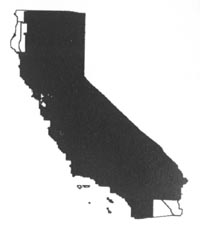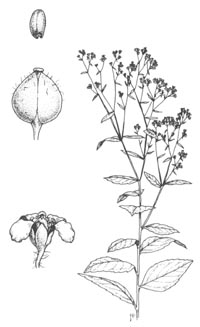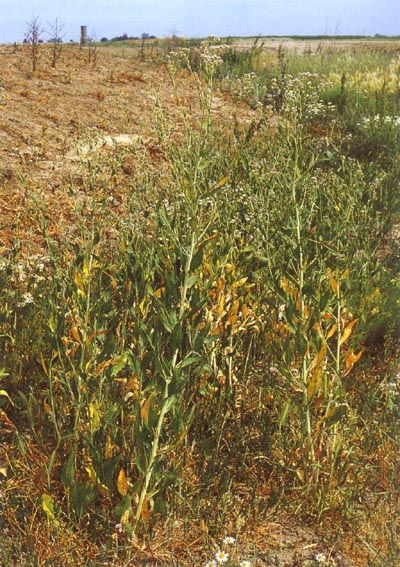|
Lepidium latifolium
|
|
|
|
Scientific name
|
Lepidium latifolium
|
|
Additional name information:
|
L.
|
|
Common name
|
perennial pepperweed; tall white top, broadleaved pepperweed
|
|
Synonymous scientific names
|
none known
|
|
Closely related California natives
|
15
|
|
Closely related California non-natives:
|
4
|
|
Listed
|
CalEPPC List A-1,CDFA B
|
|
By:
|
Ann Howald
|
|
Distribution
|
|
|
HOW DO I RECOGNIZE IT?
Distinctive features:
|
Perennial pepperweed (Lepidium
latifolium) is a multi-stemmed herb that grows three to eight feet tall
with a heavy, sometimes woody, crown and a spreading underground root system.
Stems and leaves are dull gray-green and waxy, sometimes with reddish spots. The
tiny white flowers are borne in dense clusters at the tops of the stems.
Flowering from May to July, plants produce many small, roundish, light brown
fruits. Perennial pepperweed is somewhat similar to whitetop (Cardaria draba),
but perennial pepperweed is much taller. The upper leaves do not clasp the stem
as do those of whitetop.
åÊ
|
|
Description:
|
| Brassicaceae. Perennial herb. Roots: deep and spreading. Stems: 1 to many above-ground stems 3-8 ft (1-2.7 m) tall. Stems and leaves glabrous, with gray waxy coating, appearing dull gray-green, sometimes with small reddish spots. Leaves: young plants have petioled leaves 1-2 in (2.5-5 cm) wide and 4-12 in (10-30 cm) long, arising near base of stem; older stems have alternate, sessile leaves, reduced in size upward. Leaf margins smooth or with rounded shallow teeth. Inflorescence: a panicle, 5-6 in (25-27.5 cm) wide. Flowers: white, 0.1 in (3 mm) wide; 4 sepals, white, oval, |
|
|
|
WHERE WOULD I FIND IT?
|
Perennial pepperweed invades brackish to
saline or alkaline wetlands throughout California, from the coast to the
interior and north and eastward into the Great Basin and Columbia Basin. It is
also found in native (unplanted) hay meadows and as a weed in agricultural
fields where the soil is slightly alkaline or saline. It has been found in all
counties in California except Del Norte, Humboldt, and Imperial (Young and
Turner, 1995) and is well established in marshes of the San Francisco Bay and
Delta (May 1995), including at Benicia State Park. Large infestations occur in
Suisun Marsh, especially at Grizzly Island Wildlife Area. It is also common in
the Sacramento and San Joaquin valleys, including the Sacramento National
Wildlife Refuge, Gray Lodge Wildlife Area, Kesterson National Wildlife Refuge,
and Los Banos Wildlife Area. Small infestations occur along roadsides in the
Sierra Nevada, such as along State Highway 50 south of Kyburz and at Echo Summit
(Howald, pers. observation). It is also found east of the Sierra Nevada in
native hay meadows and managed alkaline wetlands, such as at Honey Lake, and in
the Owens Valley near Bishop. Its range in southern California is not well
documented.
According to observations of wildlife area managers and others,
within the last fifteen years perennial pepperweed populations in California
have expanded, and the plant has significantly increased its overall range. In
California the plant typically grows in full sun in heavy, moist soils that are
often saline or alkaline, but it also grows in drier sites and on other soil
types. Its precise tolerance limits for aridity, alkalinity, and salinity are
unknown. In Wyoming perennial pepperweed is found on soils of high alkalinity
(pH 9.2), and it appears to tolerate, but not require, saline conditions. It is
found in all western states, and there are large infestations in
Nevada.
åÊ
|
|
WHERE DID IT COME FROM AND HOW IS IT SPREAD?
|
Perennial pepperweed is native to Eurasia, and it is now found
from North Africa north through Europe to Norway and east to the western
Himalaya (May, 1995). It has been introduced to Australia, Mexico, and
throughout much of the United States. In its native range it grows in a wide
variety of habitats, including fresh, brackish, and saltwater wetlands, in and
around agricultural fields, in waste places, and even on stony slopes, from sea
level to above 10,000 feet (3,049 m) elevation (May, 1995).
The first published record of perennial pepperweed in California
is from 1936, when it was collected on a ranch north of Oakdale in Stanislaus
County (Bellue 1936). Robbins et al. (1951) state that it may have been
introduced to California as a contaminant of sugar beet seed, although no
evidence is presented to support this. Recent localized infestations along State
Highway 50 may have been initiated from seed or plant fragments that were
contaminants in rice straw bales, since these infestations are found in areas of
recent construction where straw bales were used for erosion control (Howald
pers. observation).
Perennial pepperweed can be distributed by seeds or by pieces of
the underground stems. The small seeds have no special adaptations for
long-distance dispersal. They are capable of being transported by wind, water,
and possibly waterfowl.
åÊ
|
|
WHAT PROBLEMS DOES IT CAUSE?
|
Perennial pepperweed is an aggressive
invader of coastal and interior wetlands throughout California. It forms dense
monospecific stands that exclude other plants, including natives (Corliss 1993,
Trumbo 1994). At Grizzly Island Wildlife Area in Suisun Marsh it is encroaching
on several rare plant populations, including soft birdÛªs-beak (Cordylanthus
mollis ssp. mollis), Suisun Marsh thistle (Cirsium hydrophi-lum var.
hydrophilum), and Suisun Marsh aster (Aster lentus) (Skinner and Pavlik 1994).
In most areas it prefers habitat slightly higher than that dominated by
pickleweed (Sali-cornia spp.), but it has invaded Salicornia-dominated marshes
in the Al-viso Slough area (May, 1995), and thus poses a threat to the habitat
of the endangered salt marsh harvest mouse, California black rail, and
California clapper rail. In waterfowl nesting areas it outcompetes grasses that
provide food for waterfowl. It is also an aggressive invader of some
agricultural lands in the Central Valley and east of the Sierra Nevada. In
Lassen County it has become widely established in native (unplanted) hay
meadows, reducing the value of the hay crop (Young, pers. comm.).
åÊ
|
|
HOW DOES IT GROW AND REPRODUCE?
|
Perennial pepperweed reproduces from seed, as well as vegetatively from intact root systems or from pieces of rootstock. Flowering time varies from May to July in different parts of California. Peak bloom lasts for several weeks. Seeds mature by June or July. Each mature plant has the capacity to produce thousands of seeds each year. Seeds typically germinate in spring in wet sand or mud. Germination studies (Robbins et al. 1951, Miller et al. 1986) have shown high germination rates (64-100 percent) under a variety of conditions. Miller et al. (1986) found the highest rates occurred under alternating temperature regimes yielding germination rates as high as 64 to 96 percent in laboratory studies.
|
Seedlings grow rapidly and can produce flowering stems the first year. In fall and winter aerial stems die back to the ground, creating a thick thatch of dead stems in heavily infested areas (Young et al. 1995). In early spring new shoots begin to form from the rootstocks. A single intact root crown can produce several flowering stems. New plants readily grow from pieces of rootstock less than one-third of an inch (0.8 cm) in diameter and less than one inch (2.5 cm) long (Wotring et al. 1997).
|
(click on photos to view larger image)
|
|
|
Physical control:
|
Manual/mechanical methods: Mechanical methods are unlikely to
control perennial pepperweed because new plants quickly regenerate from pieces
of rootstock left in the soil (Young et al. 1995). Segments much shorter than
one inch (2.5 cm) are capable of resprouting. Disking of perennial pepperweed at
Grizzly Island Wildlife Area resulted in a significant increase in distribution
(Feliz, pers. comm.). Young et al. (in press) attempted to control Lepidium
latifolium in native hay meadows near Honey Lake, Lassen County, in tillage
experiments conducted from 1991 to 1992, using monthly disking throughout the
growing season. They concluded that this treatment resulted in no permanent
reduction in perennial pepperweed cover; the year following disking perennial
pepperweed reestablished approximately 100 percent cover.
Prescribed burning: Experiments at Malheur National Wildlife
Refuge in southern Oregon indicate that fire alone is unlikely to be effective
in controlling L. latifolium, in part because typical fuel loads in infestations
of this plant are inadequate to sustain burns.
Inundation: Perennial pepperweed may be intolerant of prolonged
inundation. At West Navy Marsh in Contra Costa County, perennial pepperweed
distribution and abundance were significantly reduced after a diked marsh was
returned to tidal action, increasing inundation time (May, 1995). Young and
Turner (1995) report that perennial pepperweed does not appear to survive
lengthy periods of flooding during the growing season.
åÊ
|
|
Biological control:
|
Insects and fungi: Development of a
biological control program seems unlikely because of risks to many important
crop plants that are members of the mustard family (Brassicaceae) (Young et al.
1995, Birdsall et al. 1997). Additionally, several native Lepidium species from
the western United States are either listed as endangered or are being
considered for listing (Young et al. 1995). Fifteen species of Lepidium are
native to California, including four that are considered rare and endangered by
the California Native Plant Society (Skinner and Pavlik 1994). Acknowledging
these difficulties, Birdsall et al. (1997) point out the limitations of
herbicidal control and suggest that L. latifolium-specific biocontrol agents,
either insects or fungi, be sought in the many European countries with other
native Lepidium species.
åÊ
|
|
Chemical control:
|
Attempts have been made to control perennial pepperweed with
chemical herbicides in California, Oregon, Wyoming, Idaho, and Utah. The most
effective herbicides appear to be chlorsulfuron (as Telarå¨), metsulfuron methyl
(as Escortå¨), and imazapyr (as Arsenalå¨) based on field trials of one to four
years (Cox 1997). Neither Escortå¨ nor Arsenalå¨ is registered for use in
California at this time.
Trumbo (1994) reports that tests of chlorsulfuron, triclopyr,
and glyphosate at Grizzly Island Wildlife Area in Suisun Marsh, California,
showed that each of these compounds can provide significant control of perennial
pepperweed. Chlorsulfuron (as Telarå¨) was most effective, with one application
resulting in a reduction in cover of more than 95 percent after two years.
Telarå¨ was applied at the recommended rate of 0.75-1 oz/acre, mixed in 30
gallons water with 0.5 percent non-ionic surfactant. It is selective against
broadleaved plants. This was advantageous at Grizzly Island Wildlife Area
because desirable grasses were not affected. After the initial test, large-scale
use of Telarå¨ at Grizzly Island Wildlife Area has confirmed its effectiveness;
however, retreatment may be necessary because of the regenerative ability of
perennial pepperweed. Telar exhibits some residual soil activity, and its use is
not permitted near water.
Triclopyr as Garlon3Aå¨ and Garlon4å¨ provided moderate to good
control after one year in tests at Grizzly Island Wildlife Area. Garlon3Aå¨ was
applied as a 2 percent solution with 0.5 percent non-ionic surfactant added.
Garlon4å¨ was applied as a 1.5 percent solution with 0.5 percent non-ionic
surfactant added. Currently, neither formulation of Garlonå¨ is registered for
use over water in California. Triclopyr is broadleaf-specific, so it generally
does not affect grasses. Garlon4å¨ does not show residual soil activity. As with
chlorsufuron, retreatment may be needed to maximize control.
Glyphosate as Rodeoå¨ and Roundupå¨ provided fair to moderate
control after one year in tests at Grizzly Island Wildlife Area. Roundupå¨ was
effective as a 2 percent solution. Rodeoå¨ was also used as a 2 percent solution
with the addition of 0.5 percent non-ionic surfactant. Rodeoå¨ can be used over
water, but Roundup cannot. Roundupå¨ and Rodeoå¨ are broad-spectrum herbicides
that control most plants, including grasses. At Grizzly Island Wildlife Area
resprouting of pepperweed the year following treatment indicated that several
follow-up treatments likely are needed for full control.
In Lassen County, California, Young et al. (in press) tested the
effectiveness of 2,4-D, glyphosate, and chlorsulfuron against perennial
pepperweed. They found that, while 2,4-D and glyphosate greatly reduced top
growth and eliminated seed production in the year of application, they provided
no permanent control, since cover returned to 100 percent by the second year
after application of these compounds. One application of chlorsulfuron provided
up to three years of nearly complete control of perennial pepperweed.
In Nevada, Young and others (1997) found that chlorsulfuron is
effective in controlling perennial pepperweed. The highest level of control was
obtained from applications during the bud stage. However, in the native hay
meadows where the studies were conducted, excellent control was possible with
early spring or late fall applications.
At Malheur National Wildlife Refuge in Oregon, chlorsulfuron and
metsulfuron methyl were tested alone and in combination with either fire or
disking. The herbicides were more effective when used alone, with chlorsulfuron
reducing L. latifolium densities by 100 percent in all three sites tested, and
metsulfuron methyl resulting in density reductions of 90 to 100
percent.
In Idaho herbicides used to control perennial pepperweed include
metsulfuron methyl, 2,4-D, dicamba (as Vanquishå¨), imazapyr, chlorsurfuron, and
picloram (Cox 1997). Metsulfuron methyl is the most commonly used and is
described as ÛÏquite effective.Û Other compounds noted as ÛÏsuccessfulÛ in
controlling this species include imazapyr and chlorsulfuron (Cox
1997).
In Wyoming metsulfuron methyl and chlorsulfuron proved most
effective in controlling perennial pepperweed. Either compound, used at the
recommended rate of 0.75-1.0 oz/acre, resulted in stand reductions of 90 percent
or more that persisted for four to five years.
åÊ
|




